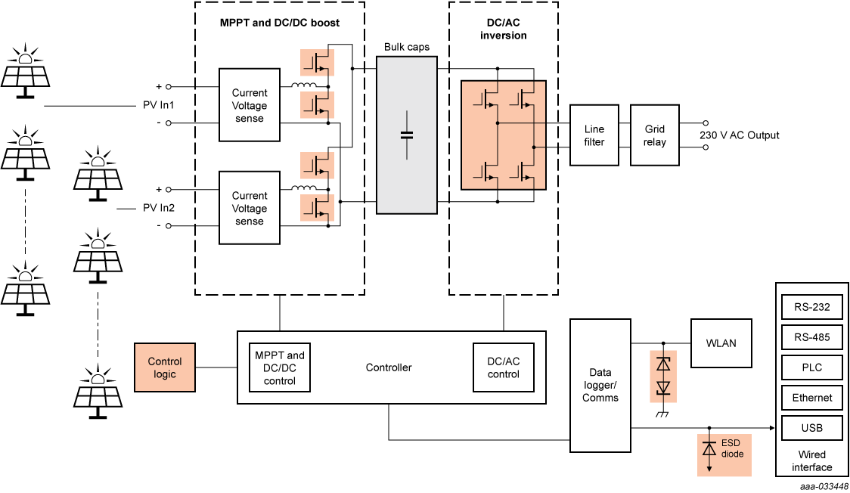When it comes to solar as a renewable power source, there have been two main challenges – efficiency and cost. While there has been massive improvement over the years, today’s 360 W to 400 W panels using the latest photovoltaic (PV) technologies still only offer around 20% efficiency when it comes to converting sunlight into electricity. To gain a boost in total system efficiency when using solar power, many engineers are switching to GaN FETs in their solar inverter designs.
There are three main steps where efficiency plays a major role when converting sunlight into usable electricity. The first and most obvious is the photovoltaic process itself. Overall panel efficiency can be influenced by many factors, including cell type and cell interconnection – with the most efficient solar panels available today using high purity monocrystalline N-type silicon heterojunction interdigitated back contact or IBC cells (PV module efficiency of 20 to 22.6%). While this is vital for the overall efficiency, it is of course not an area where Nexperia’s portfolio plays a role.
The other two steps, maximizing cell power output and DC/AC inversion, do lie within our areas of expertise. Given the power levels involved solar inverters have been dominated by high-voltage FETs and IGBTs (insulated-gate bipolar transistors). However, this is changing rapidly with the availability of wide bandgap semiconductors, and in particular 650 V GaN FETs. Not only do GaN FETs bring a significant improvement in overall conversion efficiency, effectively lowering the levelized cost of electricity (LCOE), they also make it easier to build smaller, lighter and more reliable inverters.
Giving a boost to residential installations
For residential and small commercial solar installations up to about 5 kW, systems tend to use string inverters to synchronize the phase, voltage, and frequency of the power line with that of the grid. Designs can vary depending on whether the management of the cell output is integrated into the PV cell or included as part of the inverter. The single-phase string inverter is a perfect fit for GaN devices.
Managing cell output is a key part of the efficiency equation, as PV cells have a complex relationship between temperature and total resistance that produces a non-linear output efficiency. So single phase string inverters often use a maximum power point tracker (MPPT) to maximize cell power output. From an efficiency and size perspective this is where GaN FETs can bring the most value.
Once the cell power output is maximized it can then be converter for use either directly by appliances in the house, or directed to a battery pack for storage. Despite IGBTs dominating the DC/AC stage due to their very low cost, GaN FETs allow for higher efficiency and smaller line filters. By being able to synthesize a clean sine wave, that leads to a dramatic reduction in the magnetics and heavy cooling elements. Helping to significantly reduce the overall size and bill of material (BOM) of the inverters.

Maximising grid efficiency
Of course, it is not just single-phase string inverters where GaN is having an impact when it comes to solar power. Large, grid connected PV installations require a more robust system and this is often handled by a central inverter. This megawatt rated equipment needs several kilowatts to supply all the supporting and control circuitry. So, in addition to the inverter circuitry, they also include an 5-10 kW auxiliary power supply that can be either fully integrated with internal transformer from the inverter output or with an external single-phase input connection. Just as with 80 PLUS Titanium Industrial PSU and 5G macro-cell power supplies, Nexperia’s GaN FETs help deliver the smallest, most efficient power supplies that run 24/7.